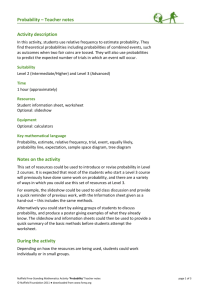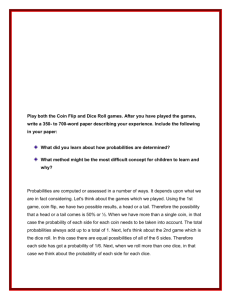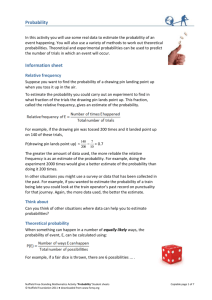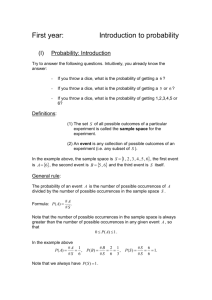Theoretical Probability
advertisement
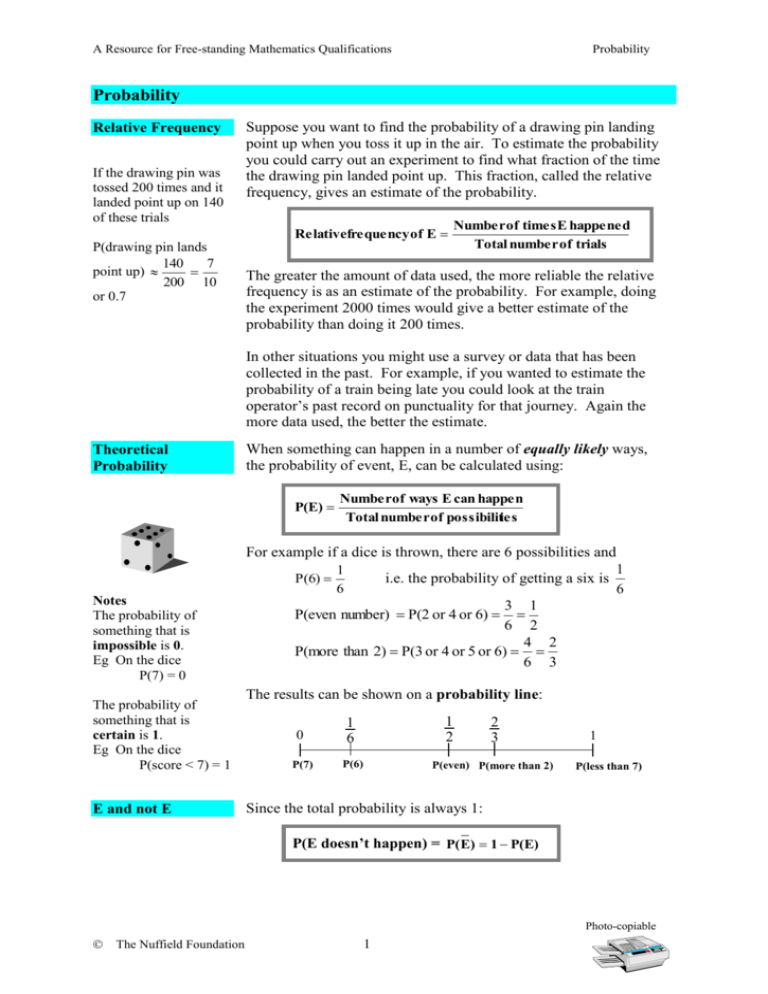
A Resource for Free-standing Mathematics Qualifications Probability Probability Relative Frequency If the drawing pin was tossed 200 times and it landed point up on 140 of these trials Suppose you want to find the probability of a drawing pin landing point up when you toss it up in the air. To estimate the probability you could carry out an experiment to find what fraction of the time the drawing pin landed point up. This fraction, called the relative frequency, gives an estimate of the probability. Relativefrequency of E P(drawing pin lands 140 7 point up) 200 10 or 0.7 Number of times E happened Total number of trials The greater the amount of data used, the more reliable the relative frequency is as an estimate of the probability. For example, doing the experiment 2000 times would give a better estimate of the probability than doing it 200 times. In other situations you might use a survey or data that has been collected in the past. For example, if you wanted to estimate the probability of a train being late you could look at the train operator’s past record on punctuality for that journey. Again the more data used, the better the estimate. Theoretical Probability When something can happen in a number of equally likely ways, the probability of event, E, can be calculated using: P(E) Numberof ways E can happen Total number of possibilities For example if a dice is thrown, there are 6 possibilities and P(6) Notes The probability of something that is impossible is 0. Eg On the dice P(7) = 0 The probability of something that is certain is 1. Eg On the dice P(score < 7) = 1 E and not E 1 6 i.e. the probability of getting a six is 1 6 3 1 6 2 4 2 P(more than 2) P(3 or 4 or 5 or 6) 6 3 P(even number) P(2 or 4 or 6) The results can be shown on a probability line: 0 1 6 P(7) P(6) 1 2 2 3 P(even) P(more than 2) 1 P(less than 7) Since the total probability is always 1: P(E doesn’t happen) = P( E) 1 P(E) Photo-copiable The Nuffield Foundation 1 A Resource for Free-standing Mathematics Qualifications Expectation Probability Probabilities can be used to make predictions. For example if a fair dice is thrown 300 times: 1 of 300 = 50 6 the expected number of sixes = Note that these probabilities were given on page 1. the expected number of even scores = 1 of 300 = 150 2 the expected number of scores above 2 = 2 of 300 = 200 3 In general: Expected number of trials in which E occurs = P(E) total number of trials Possibilities in Combined Events Possibilities for combined events can be systematically listed. eg if two coins are tossed the possibilities are: HH HT TH TT 2nd coin H T HH HT TH TT or shown in a table: 1st coin H T 2nd coin or diagram: H 1st coin H T T H HH HT TH 12 30 T TT Each of these methods gives all four possible outcomes and allows probabilities to be found. For example: 1 the probability of getting 2 heads = 4 2 1 the probability of getting a head and tail in any order = = 4 2 3 the probability of getting at least one head = 4 Photo-copiable The Nuffield Foundation 2 A Resource for Free-standing Mathematics Qualifications Probability Some to try: Lost Luggage The table gives the number of bags checked in for British Airways and bmi flights in 2007 and the number of these bags that were delayed or lost. British Airways bmi Number of bags checked in delayed/lost 43 064 346 1 141 205 5 229 520 88 902 (a) Use this data to estimate the probability that: (i) a bag checked in for a British Airways fight will be delayed or lost …………………………………………………………………………………………… (ii) a bag checked in for a bmi fight will be delayed or lost …………………………………………………………………………………………… (b) If British Airways do not deliver a bag at the end of a flight, the probability that it will be returned within 48 hours is 0.85. (i) What is the probability that a delayed bag will not be returned within 48 hours? ……………………………………………………………………………………………… 450 bags are checked in for a British Airways flight. (ii) How many of these bags do you expect to be delayed? ………………………………………………………………………………………… (iii) How many of the bags do you expect to be delayed more than 48 hours? ………………………………………………………………………………………… Dice Differences (a) The table shows the possible differences between the scores of two dice when they are thrown. One row of the table has been filled in. Complete the other rows. 1 2nd dice 2 3 4 5 6 1 2 1 0 1 2 3 4 st 3 1 dice 4 5 6 (b) Complete the table below to give the probability of each of the possible differences. 0 Difference 1 2 3 4 5 Probability (c) What is the probability that the difference is: (i) greater than 3? ………………… (ii) less than or equal to 2? ………......... Photo-copiable The Nuffield Foundation 3 A Resource for Free-standing Mathematics Qualifications Probability Three Coins 3rd coin (a) Complete the diagram to show all the possibilities when 3 coins are tossed. HHH T HHT 2 coin H (b) What is the probability that (i) all 3 coins show tails? H nd 1st coin T H ……………………… (ii) all 3 coins show the same? ……………………… …. T …. …….. …. …….. …. …….. …. …….. …. …….. …. …….. (iii) there are 2 heads and 1 tail? …. …………………….. Children (a) Each child could be a boy or girl. List all the possibilities for 3 children. …..................................................................................................................................... …………………………………………………………………………………………. (b) Assuming that any child is equally likely to be a boy or girl, find the probability that if a couple have 3 children: …………………………………. (i) all the children will have the same gender (ii) two of the children will be boys ………………………………………….. (iv) there will be more boys than girls ………………………………………….. (c) List all the possibilities for 4 children. …..................................................................................................................................... …………………………………………………………………………………………. ……………………………………………………………………………………… (d) Assuming that any child is equally likely to be a boy or girl, find the probability that a couple who have 4 children have an equal number of boys and girls. ……………………………………………………………………………………….. Photo-copiable The Nuffield Foundation 4 3rd coin A Resource for Free-standing Mathematics Qualifications Probability Teacher Notes Unit Advanced level, Hypothesis Testing Notes It is expected that most of the students who start this course will have done some work on probability before and there are a variety of ways in which you could use this set of resources. For example, the PowerPoint presentation could be used to aid class discussion and provide a quick reminder of work done previously, with Pages 1 and 2 given as a handout (includes the same methods). Page 3 gives some examples for extra practice if needed. Alternatively, you could ask learners to try Page 3 first. Or you could start by asking groups of learners to discuss probability and produce a poster giving examples of what they already know. The Powerpoint presentation and Pages 1 and 2 could then be used to provide a quick summary of the basic methods before you move on to the laws of probability. Answers Lost Luggage (a) (i) 0.0265 (to 3sf) Dice Differences (a) 1st dice 1 2 3 4 5 6 1 0 1 2 3 4 5 2 1 0 1 2 3 4 (ii) 0.0170 (to 3sf) 2nd dice 3 4 2 3 1 2 0 1 1 0 2 1 3 2 (b) (i) 0.15 (ii) 12 (iii) 2 (b) 5 4 3 2 1 0 1 6 5 4 3 2 1 0 Difference 0 1 2 3 4 5 Probability 1 6 5 18 2 9 1 6 1 9 1 18 (c) (i) 1 6 (ii) 2 3 3rd coin Three Coins (a) H HHH T HHT nd 2 coin H 1st coin H HTH T HTT H THH T THT T H Children (a) BBB, BBG, BGB, BGG GBB, GBG, GGB, GGG (b) (i) 1 4 (ii) 3 8 (iii) 1 2 (c) BBBB, BBBG, BBGB, BBGG H T BGBB, BGBG, BGGB, BGGG GBBB, GBBG, GBGB, GBGG GGBB, GGBG, GGGB, GGGG (d) H TTH T TTT 3 8 T (b) (i) 1 8 (ii) 1 4 (iii) 3 8 Photo-copiable The Nuffield Foundation 5


